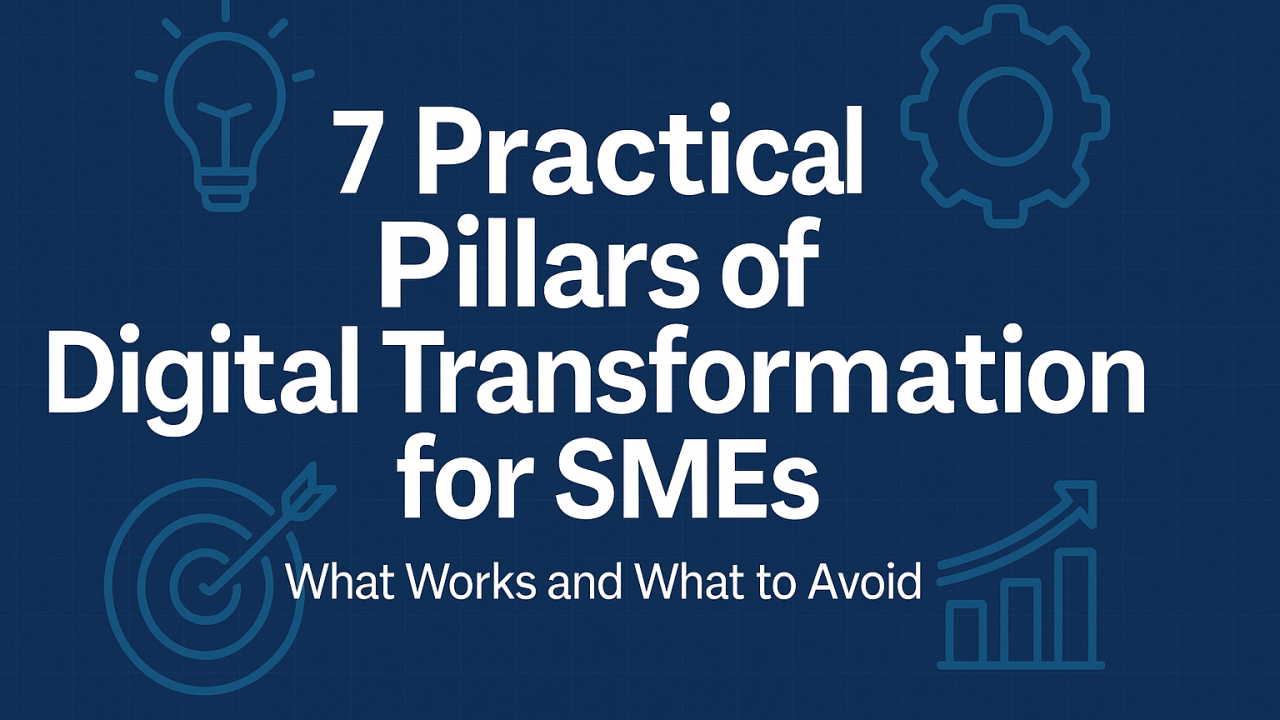7 Practical Pillars of Digital Transformation for SMEs

What Works and What to Avoid
Digital transformation isn’t just for big enterprises with sprawling IT budgets. In fact, small and mid-sized businesses (SMEs) may be better positioned to evolve—fewer layers, more agility, and closer customer feedback loops.
Yet most transformation initiatives stall or fizzle out. Why? Because many SMEs still treat digital change like a one-time software upgrade, rather than a strategic, business-first shift.
Below are 7 practical, real-world principles that have helped growing companies make digital transformation stick—without wasting time, money, or morale.
1. Start with Your Business Model, Not the Toolset
Too many SMEs start with shiny tech. But digital transformation should begin with a clear business outcome: What part of your business model needs to evolve to grow, compete, or survive? Think: moving from transactional sales to recurring revenue, digitizing service delivery, or unlocking new data monetization streams.
🛠 Make it real: Ask, “If we started this business today, how would we run it digitally from day one?”
2. Make It the CEO’s Problem—Not Just IT’s
In SMEs, digital change must have top-down energy. If the CEO or founder isn’t involved, it's seen as a side project—easy to postpone or ignore.
🔥 What works: When leadership is hands-on, transformation becomes part of daily operations, not just strategy decks.
3. Build a Cross-Functional Core Team
Digital doesn’t live in one department. You need people who understand customers, workflows, and systems at the same table.
👥 Example setup: One person from sales, one from ops, one tech-savvy problem solver. Small, empowered, and focused.
4. Fix the Customer Journey First
Digital success isn't about internal efficiency alone. It's about customer convenience, clarity, and control.
🎯 Simple wins:
- Self-service forms for scheduling or estimates
- Digital signatures and payment links
- Real-time status updates via SMS or email
Ask: “What frustrates our customers the most—and how can we fix it with digital?”
5. Think in 90-Day Outcomes
Transformation doesn’t have to take years. In fact, long timelines are riskier for SMEs. Focus on quick, high-impact wins.
⏱ Suggested goals:
- Launch a digital quoting tool in 3 months
- Reduce invoicing time by 50%
- Improve first response time by 2 hours
Momentum > perfection.
6. Invest in People Before Platforms
Even the best software fails without buy-in. Your team needs training, context, and psychological safety to adapt.
📚 Smart move: Budget for learning. Recognize digital champions internally. And build in time to experiment—without penalty for “failures.”
7. Measure Business Impact, Not Just Activity
Don’t stop at “we launched the tool.” Measure whether it’s working.
📊 Better metrics:
- Customer retention
- Revenue per employee
- Time to fulfill an order
- Cost to serve a customer
If you can’t see the change in your bottom line, it’s not transformation—it’s busywork.
Final Thought:
Digital transformation for SMEs isn’t about complexity—it’s about clarity. Focus on customer value, business alignment, and fast, measurable execution. You don’t need a big team to make a big shift. Just the right one.

